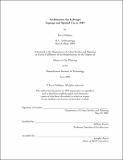| dc.contributor.advisor | William Porter. | en_US |
| dc.contributor.author | Goldman, Ezra (Ezra Joshua) | en_US |
| dc.contributor.other | Massachusetts Institute of Technology. Dept. of Urban Studies and Planning. | en_US |
| dc.date.accessioned | 2008-02-04T16:04:49Z | |
| dc.date.available | 2008-02-04T16:04:49Z | |
| dc.date.copyright | 2007 | en_US |
| dc.date.issued | 2007 | en_US |
| dc.identifier.uri | http://hdl.handle.net/1721.1/40099 | |
| dc.description | Thesis (M.C.P.)--Massachusetts Institute of Technology, Dept. of Urban Studies and Planning, 2007. | en_US |
| dc.description | This electronic version was submitted by the student author. The certified thesis is available in the Institute Archives and Special Collections. | en_US |
| dc.description | Includes bibliographical references (p. 47-50). | en_US |
| dc.description.abstract | Individuals have a particular set of tasks they need to accomplish or what might be called a "life pattern." These tasks must be accomplished within a particular set of places or "life spaces." What is the role of the laptop in defining these life spaces and patterns and how does it either enable or constrain an individual from acting out their life pattern within a particular life space? This study uses a variety of quantitative and qualitative analytical methods for understanding the adaptation of student behavior to new technologies on MIT campus with a focus on the Sloan School of Management. Laptops will only enable spatial flexibility if the nature of one's work ("life pattern") affords it (Norman, 1999), "mobility" or "flexibility" is perceived to be advantageous, and there are suitable behavior settings (Barker, 1989; Schoggen, 1989) within their "life space." Most students are not creating "a new office" (Duffy, 1997) or choosing "special places" (Mitchell, 2003) to work. They mostly choose to use a very limited range of locations, often similar to office-type spaces. Only an exceptional minority of most techno-enabled are becoming free roaming "neonomads" (Abbas, 2005). | en_US |
| dc.description.abstract | (cont.) Rather than being more "mobile," most people are now more "connected" wherever they go (Castells, 2006). Instead, they might rather be labeled technologically enhanced cyborgs (Mitchell, 2003, Picon, 2000). Our relationship to the physical surrounding environment changes depending on the degree to which we require our technological enhancements and how much our cyborg selves are supported by that environment. | en_US |
| dc.description.statementofresponsibility | by Ezra Goldman. | en_US |
| dc.format.extent | 50 p. | en_US |
| dc.language.iso | eng | en_US |
| dc.publisher | Massachusetts Institute of Technology | en_US |
| dc.rights | M.I.T. theses are protected by copyright. They may be viewed from this source for any purpose, but reproduction or distribution in any format is prohibited without written permission. See provided URL for inquiries about permission. | en_US |
| dc.rights.uri | http://dspace.mit.edu/handle/1721.1/7582 | |
| dc.subject | Urban Studies and Planning. | en_US |
| dc.title | Architecture for Cyborgs : laptops and spatial use at MIT | en_US |
| dc.title.alternative | Laptops and spatial use at MIT | en_US |
| dc.type | Thesis | en_US |
| dc.description.degree | M.C.P. | en_US |
| dc.contributor.department | Massachusetts Institute of Technology. Department of Urban Studies and Planning | |
| dc.identifier.oclc | 187144185 | en_US |
